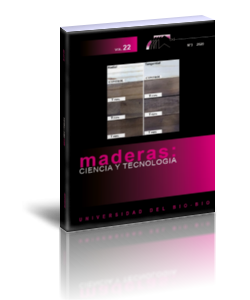Lightweight tubular fiberboard: Effect of hole diameters and number on panel properties
Keywords:
Fiberboard, lightweight, tubular board, extrusion, furniture applicationAbstract
Special tubular fiberboard with a density of 550 kg/m3 was manufactured using the round rods for creation of the holes. Physicomechanical properties of tubular fiberboard (6, 8, 10, 12 (mm)) with various hole diameters and number of hole (0, 1, 2 and 3 in a constant cross section) were evaluated. The surface layers density, especially on top of the holes, considerably elevated with increasing the hole diameter. This did create higher bending properties as well as higher internal bond and surface soundness. The structure of webs between the holes, when the holes’ number increases, were predominant factor influencing the panel properties. Weak and loose web structure were obtained by increasing the holes’ number from 1 to 3 within a constant cross section (50 mm × 16 mm) that was due to the less transferred fiber during pressing in the webs’ sections. A corresponding comparison of panel properties with those in American and European standards presents that the minimum requirements according to most of the standards (ANSI A208/2, EN 14755, EN 312/P2 and EN 622-5/P1) were obtained.
Downloads
References
Bowers, H.E.; Ohio, D.; Kritchever, M.E.; III, W. 1956. Manufacture of fiber board by extrusion. United States Patent (US2759222). United States of America.
Cai, Z.; Muehl, J.H.; Winandy, J.E. 2006. Effects of panel density and mat moisture content on processing medium density fiberboard. Forest Prod J 56(10): 20-25. https://www.fs.usda.gov/treesearch/pubs/25741
Colautti, S.; Pisa, C. 2016. The European market for RTA furniture. CSIL reports EU10, Centre for Industrial Studies (CSIL), Milano, Italy. https://EconPapers.repec.org/RePEc:mst:csilre:eu10
Déneši, M.; Joščák, T.; Joščák, M.; Bodnár, F.; Teischinger, A. 2012. One press cycle production of fiberboard with unsymmetrically distributed densities. Eur J Wood Prod 70(4): 471-477. https://doi.org/10.1007/s00107-011-0561-z
Dziurka, D.; Mirski, R.; Dukarska, D.; Derkowski, A. 2015. Possibility of using the expanded polystyrene and rape straw to the manufacture of lightweight particleboards. Maderas-Cienc Tecnol 17(3): 647-656. http://dx.doi.org/10.4067/S0718-221X2015005000057
Eckelman, C. 1975. Screwholding performance in hardwoods and particleboard. Forest Prod J 25(6): 30-35.
European Committee for Standardization. 1993. EN 310: Wood-based panels – Determination of modulus of elasticity in bending and of bending strength.
European Committee for Standardization, Brussels, Belgium. https://standards.cen.eu/index.html
European Committee for Standardization. 1993. EN 317: Particleboards and fibreboards – Determination of swelling in thickness after immersion in water.
European Committee for Standardization, Brussels, Belgium. https://standards.cen.eu/index.html
European Committee for Standardization. 1993. EN 319: Particleboards and fibreboards – Determination of tensile strength perpendicular to the plane of the board. European Committee for Standardization, Brussels, Belgium. https://standards.cen.eu/index.html
European Committee for Standardization. 1993. EN 622: Fibreboards. Specifications – Part 1: General requirements. European Committee for
Standardization, Brussels, Belgium. https://standards.cen.eu/index.html
European Committee for Standardization. 2002. EN 311: Wood-based panels – Surface soundness – Test method. European Committee for Standardization,
Brussels, Belgium. https://standards.cen.eu/index.html
European Committee for Standardization. 2005. EN 14755: Extruded particleboards - Specifications. European Committee for standardization, Brussels, Belgium. https://standards.cen.eu/index.html
European Committee for Standardization. 2010. EN 312: Particleboards. Specifications. European Committee for standardization, Brussels, Belgium. https://standards.cen.eu/index.html
FAO. 2018. Global production and trade of forest products. Food and Agriculture Organization of the United Nations. http://www.fao.org/forestry/statistics/80938/en/
Geimer, R.L.; Montrey, H.M.; Lehmann, W.F. 1975. Effects of layer characteristics on the properties of three-layer particleboards. Forest Prod J 25(3): 19-29. https://www.fpl.fs.fed.us/documnts/pdf1975/geimer75c.pdf
Haas, G.V: Frühwald, A. 2000. Untersuchungen zum Verdichtungsverhalten von Faser-, Span-und OSB-Matten (Compression behavior of fibre particle and strand mats). Holz Roh Werkst 58(5): 317-323. https://doi.org/10.1007/s001070050437
Hein, P.R.G.; Brancheriau, L. 2018. Comparison between three-point and four-point flexural tests to determine wood strength of Eucalyptus specimens. Maderas-Cienc Tecnol 20(3): 333-342. http://dx.doi.org/10.4067/S0718-221X2018005003401
IBM SPSS Statistics. 2010. IBM SPSS Statistics Software Version 19.0. IBM. https://www.ibm.com/analytics/spss-statistics-software
Klasterka, S. 2003. Method for dispersing particles in order to form a nonwoven. European Patent Office (EP1140447B1).
Kollman, F.F.P.; Kuenzi, E.W.; Stamm, A.J. 1975. Principles of Wood Science and Technology. II Wood Based Materials. Springer, Berlin, Heidelberg. https://doi.org/10.1007/978-3-642-87931-9
Ohba, S.; Sasada, T.; Kawai, S. 2001. Development of vertically oriented fiberboard I. Manufacture of fiberboards and analysis of fiber orientation. (Jappanies) Mokuzai Gakkaishi 47(2): 138-149. http://www.jwrs.org/editor/mkz_toc/mkz_main-e.php
Rowell, R.M.; Kawai, S.; Inoue, M. 1995. Dimensionally stabilized, very low density fiberboard. Wood Fiber Sci 27(4): 428-436. https://wfs.swst.org/index.php/wfs/article/view/1724
Jafarnezhad, S.; Shalbafan, A.; Luedtke, J. 2018. Effect of surface layers compressibility and face-to-core-layer ratio on the properties of lightweight hybrid panels. Int Wood Prod J 9(4): 164-170. https://doi.org/10.1080/20426445.2018.1546979
Sackey, E.K.; Semple, K.E.; Oh, S.W.; Smith, G.D. 2008. Improving core bond strength of particleboard through particle size redistribution. Wood Fiber Sci 40(2): 214-224. https://wfs.swst.org/index.php/wfs/article/view/752
Shalbafan, A.; Welling, J.; Luedtke, J. 2013. Effect of processing parameters on physical and structural properties of lightweight foam core sandwich panels. Wood Mater Sci Eng 8(1): 1-12. https://doi.org/10.1080/17480272.2012.684704
Shalbafan, A.; Rheme, M.; Thoemen, H. 2017. Ultra-light particleboard: characterization of foam core layer by digital image correlation. Eur J Wood Prod 75(1): 43-53. https://doi.org/10.1007/s00107-016-1088-0
Thoemen, H.; Ruf, C. 2008. Measuring and simulating the effects of the pressing schedule on the density profile development in wood-based composites.
Wood Fiber Sci 40(3): 325-338. https://wfs.swst.org/index.php/wfs/article/view/1139
Wong, E.D.; Zhang, M.; Han, G.; Kawai, S.; Wang, Q. 2000. Formation of the density profile and its effects on the properties of fiberboard. J Wood Sci 46(3): 202-209. https://doi.org/10.1007/s002260050119
































